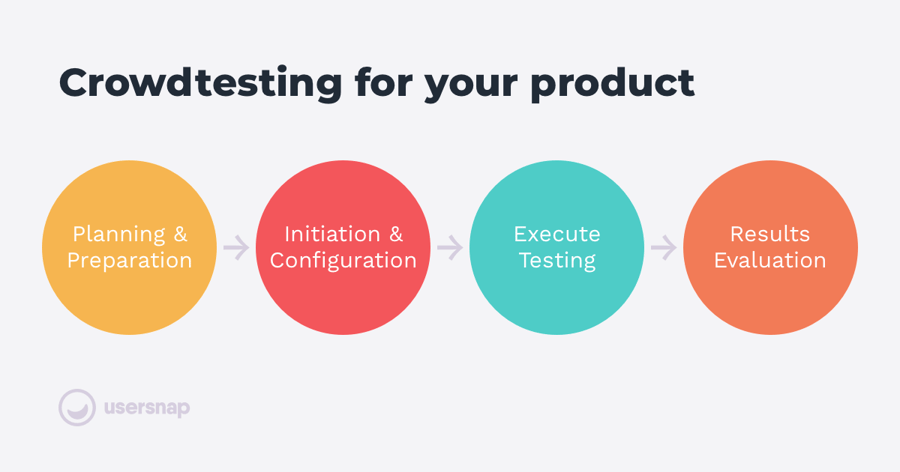
The ways in which consumers interact with the world of eCommerce is as changeable and varied as the consumers that engage with it. Rapid growth in digital technologies and mobile spaces is continually morphing to meet the demands of a multifaceted market base. But this growth has also created a unique challenge where immediate and continuous testing is vital.
As interconnected technologies continue expanding to appease the eCommerce masses, the likelihood of bugs, shortfalls, and glitches also increases. Assuming that traditional means can manage these hyper-modern tech issues isn’t just flawed, it could end up costing huge amounts of money and resources. This is where crowd testing comes into play in a big way.
Crowd testing engages a large, remote group of anonymous testers with a kaleidoscope of unique experiences to test your tech. The result is finding real-world bugs using real-world people that emulate the actual customer experience. This information, when collected and gathered, can trigger invaluable tweaks to a company’s user interface (UI).
Crowd testing isn’t some big secret that will unlock success and riches only for a lucky few. It’s indeed one part of contemporary eCommerce best practices. The not-so-secret secret is that crowd testing is something that everyone is doing, but why is it so vital to eCommerce, and how can you crowd test the right way?
What Is Crowd Testing and How Does It Work?
Crowd testing is a relatively cheap, real-world testing approach spanning many different types of platforms. Before we can see just exactly how much more than this it is, we need to know how it works in the first place.
A hybrid of software testing and crowdsourcing, crowd testing takes place at a crucial point in software development. After all the hard work of actually building the software, it needs to be tested. Traditional quality assurance (QA) testing alone simply can’t keep up with the expanding amount of pages, visual elements, interactive content, and links necessary to keep customers buying in the eCommerce universe.
To put it bluntly, QA testing is a bit old-fashioned when faced with the evolving demands of today’s customers and the strain this puts on software. Companies need to consider their requirements, what they hope to achieve, project size, and of course, budget when choosing a software test methodology. Traditional QA testing can be costly, slow, robotic, and detrimental.
Crowd testing, however, is a scalable testing solution that can pick up the slack of traditional QA testing options. Software gets distributed to a large group of remote testers who then run this software on their own computers, tablets, and mobile phones and inspect it for bugs, glitches, and defects while looking for areas for potential improvement.
The Phases of Crowd Testing

There are five general phases for implementing a crowd testing process:
Phase I – Planning and preparation phase
This is the preliminary phase where companies identify testing scope, define the background context, identify tester skill set, make test plans, and specify budgets and deliverables.
In this phase, everything needs to be considered in advance. Does your business have the scope of potentially communicating with a large group of people, or will you need to invest in a video conferencing tool? How will your team collect data? Who will be responsible for implementing changes?
Phase II – Initiation & configuration phase
This phase is the preparation phase in which test cases are prepared. Functional scenarios and requisite data for executing test cases are defined and technical configurations on application and test environments are completed.
Phase III – Execution phase
This is where the crowd testers get their chance to interact, communicate, test, and put your software under a microscope.
Phase IV – Results evaluation phase
Identified bugs and glitches are classified as per the severity and addressed during this phase.
Phase V – Completion phase
Results are presented during this phase and the test cycle is closed.
Why Is Crowd Testing Vital to eCommerce?
The implications of crowd testing are incredibly wide-reaching despite the actual simplicity of the concept itself. Traditional in-house testing relies on a small group of potentially biased individuals. Crowd testing diversifies the testing process with real-time experiences where multiple crowd testers use platforms in different locations to emulate the real world.
Benefits of Crowd Testing
Taking your software testing to the street, as it were, can have all kinds of benefits for your company’s testing capabilities and subsequent results:
- Crowd testing provides flexibility. Testing amongst many competent individuals rather than relying on automation means that implemented changes are more easily integrated into the testing process. This isn’t just ideal, but necessary, to keep up with the demands of consumers.
- It’s cheaper than QA testing. QA testing is all about careful, meticulous planning and specialist execution. This work will of course add up. By incorporating even just a small amount of crowd testing into your strategy, you could save money in a big way.
- It welcomes dynamism. Crowd testing mimics how real people engage with eCommerce websites in ways that scripted and traditional methods could never fully account for. This dynamic approach allows for the possibility of finding way more issues because it allows testers the freedom to choose the ways in which they interact.
- Testing happens in real-time. Crowd testing is a lightning-fast method of identifying faults. If faults can be identified quickly, they can be resolved quickly. In this way, fixing faults and re-testing can happen almost simultaneously.
- The potential customer is also the tester. Really, the hunted has truly become the hunter when it comes to crowd testing. What better way to test how your software will cope in the real world than literally handing it over to testers in the real world?
How to Incorporate Crowd Testing into the Bigger Picture

The process of crowd testing is quite simple on paper, but it takes planning. Before you unleash your website to hungry crowd testers, companies need to:
- Define the project’s aims
- Set a budget
- Choose whether they want to work directly or indirectly with your testers
- Research crowd testing companies to choose the best one for their needs
Beyond having a crystal clear plan of action, it’s important to integrate crowd testing into the larger arena of multifaceted approaches to eCommerce. This is how to crowd test the right way. So, what things can you do to ensure you’re using crowd testing in a way that promotes overall business ingenuity?
1. Work with Complimentary Automated Testing
Also known as the "don’t throw the baby out with the bathwater" rule, remember that you can use crowd testing in tandem with other, more traditional methods of testing software. There are so many ways in which automated testing systems can still help your business grow in the eCommerce space.
An email verification system, for example, is an invaluable partner-in-crime when it comes to keeping up with both soft and hard email bounces. By doing the otherwise time-consuming dirty work to ensure your emails are verified, you can more easily ensure that you’re avoiding soft and hard email bounces.
This is just one way in which automation can still add value to your eCommerce business. And, even beyond the scope of automation, in which test scripts are integrated after code development, a continuous testing methodology can also be employed. So, exactly what is continuous integration testing?
Simply, continuous testing prevents the need for manual testing at all and is actually fully automated. Test scripts are developed before the coding even begins. These scripts are created in response to what the product should be doing. These test scripts then run continuously as soon as the new code has been integrated, so testing and fixing can happen simultaneously.
2. Work with a Fulfillment Center
As absolutely fanciful as the name sounds, fulfillment centers are simply a practical way to outsource order fulfillment so you have more time to make sure things are running as optimally as you need them to. The fact of the matter is, inventory management does not need to take up so much of your precious time.
A fulfillment center, simply, enables businesses to outsource their warehousing and order fulfillment needs. But it’s so much more than just a warehouse. In a fulfillment center, storage is only one aspect of what goes on behind the scenes. A fulfillment center handles the full order fulfillment process from order picking to packing and finally shipping.
But there’s more. Fulfillment centers can now also handle some aspects of customer service including exchanges and returns and some customer queries. Some even operate a dedicated contact center service on behalf of their eCommerce retail clients.
3. Work with an Automation COE
New methods require and deserve new ways of thinking about eCommerce best practices. Establishing a Center of Excellence (COE) can help transition businesses from old methods to better, more current ones. A COE isn’t a physical center, though. It’s a team established to provide best practices, leadership, research, training, and/or support for automated processes.
An automation COE, then, includes the people, processes, and technology necessary to maximize the benefits of automation within an organization. Another way to use automation to your advantage, an automation COE is crucial to finding new automation opportunities and carrying out a long-term vision.
Automation software itself has also moved beyond what was previously possible, and a center of excellence will help align and establish how it can be utilized to suit your needs. In an organization with a center of excellence, different roles work together in a structured way so each can contribute their unique skills to furthering the objectives of the business.
The Changing Landscape of eCommerce
Being able to change, grow, and adapt has always been crucial for a successful business. Now, however, the speed at which this must take place is exponentially increasing as software and consumer practices become more and more sophisticated.
Rapid sophistication has led to an increased demand for software maintenance and updates that happen just as quickly. But beyond this, the necessity for a culture of quality has truly established itself within this sphere. Striving for the best at every level, at all times, is integral for both employer and employee in today’s eCommerce environment.
This has led to an eCommerce atmosphere where slow or reactive testing solutions are being rapidly replaced by adaptive and flexible planning and continuous improvement and implementation. This exploratory testing approach ditches long, drawn-out QA testing processes and replaces it with discovery, investigation, learning, and adapting on a constant basis.
The Bottom Line
Negative online feedback is just a finger’s swipe away and can absolutely devastate any eCommerce endeavor. In a world where information can go viral instantly, companies simply can’t afford to leave the capabilities of their software up to chance. But with a solid plan of action, crowd testing can provide invaluable insight to help navigate these murky waters.





Leave a reply or comment below